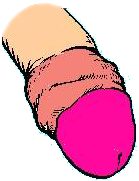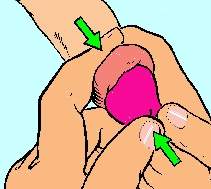When the foreskin is trapped behind the glans and can not go forward, that is called paraphimosis.  It may mean no more than being the owner of a broad glans and/or a short foreskin, but it can be a medical emergency. If the retracted foreskin becomes swollen with fluid (oedematous), its appearance can be very alarming. This may happen if you fall asleep with your foreskin retracted, for example. If its colour is bright red, there is no need for concern - yet. If you have a retracted foreskin and
This is one of the very few things that can go seriously wrong with an intact penis and not a circumcised one. (So it's a wonder it hasn't been heavily promoted as a reason to circumcise babies.) How to bring it back  If the patient is a child, the person reducing the paraphimosis by this method needs to know that the process will hurt, but only momentarily. One good way to reduce the swelling is by covering the penis in ordinary (granulated) sugar. This draws the fluid out of the penis by osmosis (the old high school water-through-a-membrane trick). If this fails, it is important to see a doctor. S/he can draw off the fluid with a hypodermic needle or, as a last resort, cut through the tight band. Recently another method has been recommended, the "Dundee technique". This involves pricking the swollen prepuce about 20 times (under anaesthetic) and letting the fluid escape. The doctor may then recommend circumcision or try to order it, maybe telling you tales of necrosis, gangrene and autoamputation ("You penis will fall off!") to scare you into it. Circumcision will remove any chance of this happening again. But if the doctor has put a slit in your foreskin, that is probably enough and it won't happen again. Otherwise, it's up to you whether you think you can trust yourself to act in time next time - as you did this time. You're hardly likely not to notice that your foreskin is retracted. It also depends how much you value your foreskin. The commonest cause of paraphimosis is iatrogenic (doctor-caused), when a catheter (drainage tube) is put in your penis and your foreskin is not brought forward again - probably because the doctor or nurse is unfamiliar with the normal foreskin. (Picture of a iatrogenic paraphimosis. Note the catheter.) The catheter pushing out from inside and the foreskin constricting from outside combine to produce the paraphimosis. The catheter needs to be removed before the paraphimosis is reduced. No catheter, no paraphimosis, and no need for circumcision. The catheter can be put back, the foreskin pulled forwards and paraphimosis will not occur again. Veteran Intactivist Marilyn Milos RN writes:
For information about the opposite case, a foreskin that will not go back behind the glans, see phimosis. Based on an article and a pamphlet in the American Family Physician, but written in a more foreskin-friendly way. This page may not offer medical advice, but a doctor has checked and approved it. This page may also be downloaded as a Word document or in .pdf format (which requires Adobe Acrobat Reader ). |
